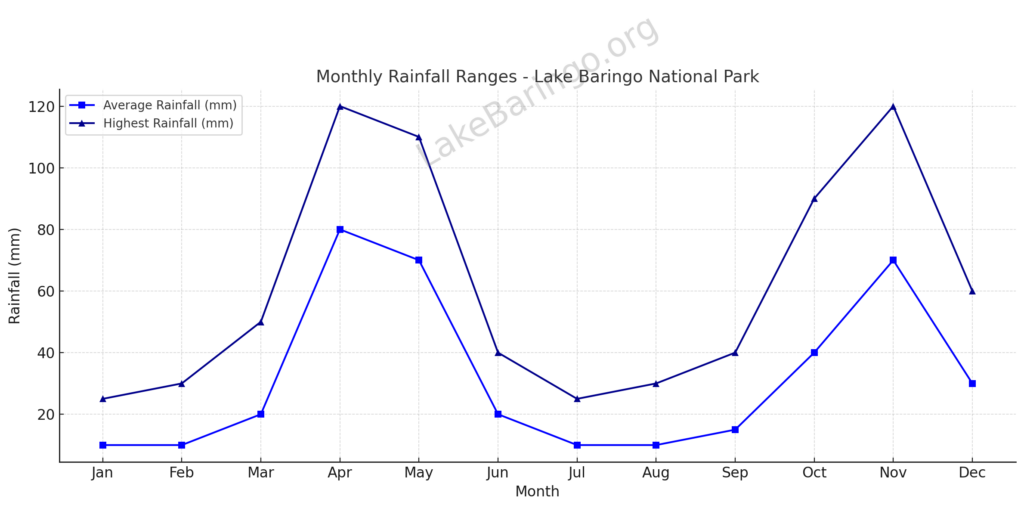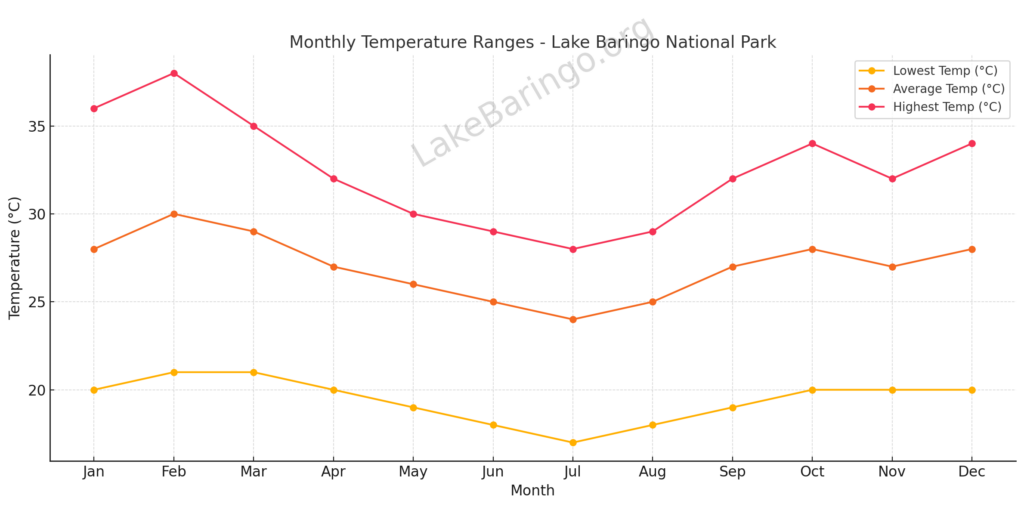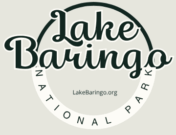What to Expect Each Month in Kenya’s Arid Freshwater Paradise
Lake Baringo NP lies in the semi-arid northern Rift Valley of Kenya at about 970 meters (3,180 feet) above sea level. The area experiences hot daytime temperatures, cooler nights, and a pattern of two rainy seasons each year.
🌍 Overview of Lake Baringo’s Climate
- Location: Baringo County, Kenya (approx. 970m above sea level)
- Climate Type: Semi-arid
- Temperature: Warm to hot year-round (average 25–35°C / 77–95°F)
- Rainfall Pattern: Bimodal—short rains (Oct–Dec), long rains (Mar–May)
- Humidity: Generally low, but higher during rainy seasons
- Wind: Breezy in the afternoons, especially near the lake surface
Lake Baringo’s semi-arid setting, coupled with its freshwater ecosystem, creates a unique microclimate that supports diverse flora, fauna, and year-round travel.
🔹 Climate Type: Semi-arid tropical
🔹 Annual Rainfall: 500–700 mm (mostly April–May and October–November)

🔹 Temperature Range:
- Daytime highs: 28–38°C (82–100°F)
- Nighttime lows: 16–22°C (61–72°F)
Because of its low altitude, Baringo is hotter and drier than other Kenyan parks like Maasai Mara or Aberdares.


🗓️ Month-by-Month Weather Guide
January
- 🌤️ Hot and dry
- Temps: 30–36°C (day), 20–24°C (night)
- Ideal for: Birding, boat rides, reptile spotting, photography
- Notes: One of the sunniest and driest months; minimal rain
February
- ☀️ Hottest month of the year
- Temps: 32–38°C, can exceed 40°C on some days
- Ideal for: Dryland wildlife, reptiles, clear skies
- Notes: Stay hydrated; very dry with dusty winds in afternoons
March
- 🌦️ Start of the long rains (late month)
- Temps: 28–35°C
- Ideal for: Early migrant birds, fewer tourists
- Notes: Occasional thunderstorms begin late in the month
April
- 🌧️ Peak of long rains
- Temps: 25–30°C, humid
- Ideal for: Green landscapes, amphibians, dramatic skies
- Notes: Roads can be muddy; fewer tourists; intense afternoon showers
May
- 🌧️ Rainy but clearing toward end of month
- Temps: 24–29°C
- Ideal for: Bird nesting season, lush vegetation, cooler temperatures
- Notes: Great for photographers; occasional flooding near lake edge
June
- ⛅ Cooler, mostly dry
- Temps: 23–28°C
- Ideal for: Boat safaris, walking tours, raptors
- Notes: Transition to dry season; crisp mornings and clear skies
July
- 🌤️ Dry, cool mornings
- Temps: 22–27°C (coolest month)
- Ideal for: Hiking Tugen Hills, cultural visits, boat trips
- Notes: Pleasant all-day conditions; ideal for outdoor explorers
August
- 🌤️ Dry, slightly warming
- Temps: 24–29°C
- Ideal for: Family trips, nature walks, hot springs visits
- Notes: Very clear skies; wildlife active in mornings and evenings
September
- 🌞 Warming up, dry
- Temps: 26–32°C
- Ideal for: Bird migration season starts, fewer crowds
- Notes: Transitional period before short rains begin
October
- 🌦️ Short rains begin (late October)
- Temps: 27–33°C
- Ideal for: Return of Palearctic migrant birds
- Notes: Occasional showers; vegetation begins to green again
November
- 🌧️ Peak of short rains
- Temps: 25–30°C
- Ideal for: Birdwatching (migration peak), dramatic clouds
- Notes: Afternoon storms common; great for Flamingo sightings nearby
December
- 🌤️ Rain tapers off, warm and fresh
- Temps: 26–32°C
- Ideal for: Festive family trips, birding, boat excursions
- Notes: Stunning sunsets and green landscapes return
| Month | Avg Temp (°C) | Rainfall | Climate Summary | Best For |
|---|---|---|---|---|
| January | 30–36 (hot) | Low | Hot, dry, and sunny. Clear skies, dusty conditions. | Birding, boat safaris, photography |
| February | 31–38 (very hot) | Very low | Peak heat. Little to no rain. Some water evaporation. | Great for reptiles, birding, fewer tourists |
| March | 30–36 | Starts rising | Hot and increasingly humid. Pre-rains begin late. | Transition month—mixed dry/wet experiences |
| April | 28–33 | High | Long rains begin. Thunderstorms in afternoons. | Green landscapes, active frogs, fewer crowds |
| May | 26–31 | High | Rains continue but taper. Wet trails, lush views. | Amphibians, insects, budget travel |
| June | 27–32 | Moderate-low | Cooler mornings, less rain. Drying bushland begins. | Hiking, cultural visits, birding |
| July | 26–31 | Low | Dry, clear, and warm—not as hot as Jan/Feb. | Boat rides, cliff walks, family travel |
| August | 26–32 | Low | Similar to July. Calm weather, great visibility. | Photography, birding, nature walks |
| September | 28–34 | Low-moderate | Hot and dry; rain may start late in the month. | Birdwatching picks up; local festivals |
| October | 27–33 | Rising | Short rains begin. Intermittent showers. | Breeding birds, fewer tourists |
| November | 26–32 | High | Peak of short rains. Afternoon downpours. | Migratory birds arrive, vivid landscapes |
| December | 28–33 | Moderate | Rains ease; warm days, cooler evenings. | Good birding, comfortable travel |
🦅 Best Months for Birdwatching
| Season | Highlights |
|---|---|
| Nov–Apr | Palearctic migrants, breeding plumage, high diversity |
| Jun–Oct | Dry season residents, raptors, hornbills, ground birds easier to spot |
🐊 Best Months for Boat Safaris & Reptiles
- Jan–Mar: Dry and hot – reptiles are highly active, and hippos are easily seen on shores.
- Jun–Aug: Mild weather, calm waters – best for photography and scenic boat tours.
🌧️ Rainfall Patterns & What to Expect
| Rain Season | Months | Details |
|---|---|---|
| Long Rains | April–May | Afternoon storms, green scenery, slippery trails, potential flooding in lowlands |
| Short Rains | Oct–Nov | Short-lived showers, typically in late afternoon or evening, good for birds |
| Dry Season | Jan–Mar, Jun–Sept | Sunny, clear skies, best conditions for walking, boating, and wildlife viewing |
💡 Note: Unlike highland parks, Baringo’s rains are less predictable and vary by year. Some years may have extended droughts or early/late rains.
🌅 Best Time to Visit Lake Baringo National Park
- Overall Best Months: November to February
- High bird activity, great light, and comfortable conditions
- Dry Season (July–October): Excellent for boat safaris, hikes, and photography
- Budget or Quiet Travel: April–May (wet season discounts, fewer tourists)
🧳 What to Pack Based on Season
| Dry Season (Jan–Mar, Jul–Oct) | Wet Season (Apr–May, Oct–Nov) |
|---|---|
| Light breathable clothing | Lightweight rain jacket |
| Hat, sunglasses, sunscreen | Waterproof boots or sandals |
| Binoculars, bird book | Fast-drying clothes, extra socks |
| Refillable water bottle | Insect repellent (especially in rainy evenings) |
| Long sleeves for evening mosquitoes | Camera rain cover or zip-lock for electronics |
⚠️ Weather-Related Travel Tips
- Roads can be rough after rain, especially around Kampi ya Samaki—use 4×4 vehicles.
- Lake levels fluctuate due to rainfall; lodges or islands may become temporarily inaccessible.
- Rains are usually short and intense, not all-day affairs—plan outdoor activities early in the day.
🌿 How Climate Affects Wildlife
- Birds: Migration, breeding, and feeding tied to rainfall and vegetation
- Hippos: Come closer to shores during dry periods; more active at dusk
- Fish & Reptiles: Breed and bask more actively in hot, dry months
- Flamingos & Waterbirds: Their presence depends on algae growth and lake chemistry, which are rain-influenced
🔚 Final Thoughts: Lake Baringo’s Weather is Wildly Beautiful
Lake Baringo’s semi-arid setting delivers sunshine almost year-round, making it a reliable destination for travelers seeking warmth, wildlife, and peace. While the rains bring green beauty and birdsong, the dry seasons offer clarity, wildlife visibility, and dramatic views of escarpments, lava fields, and volcanic islands.
🗓️ Whether you’re planning a January birding tour or a July photo safari, Lake Baringo has the climate to match your adventure.
